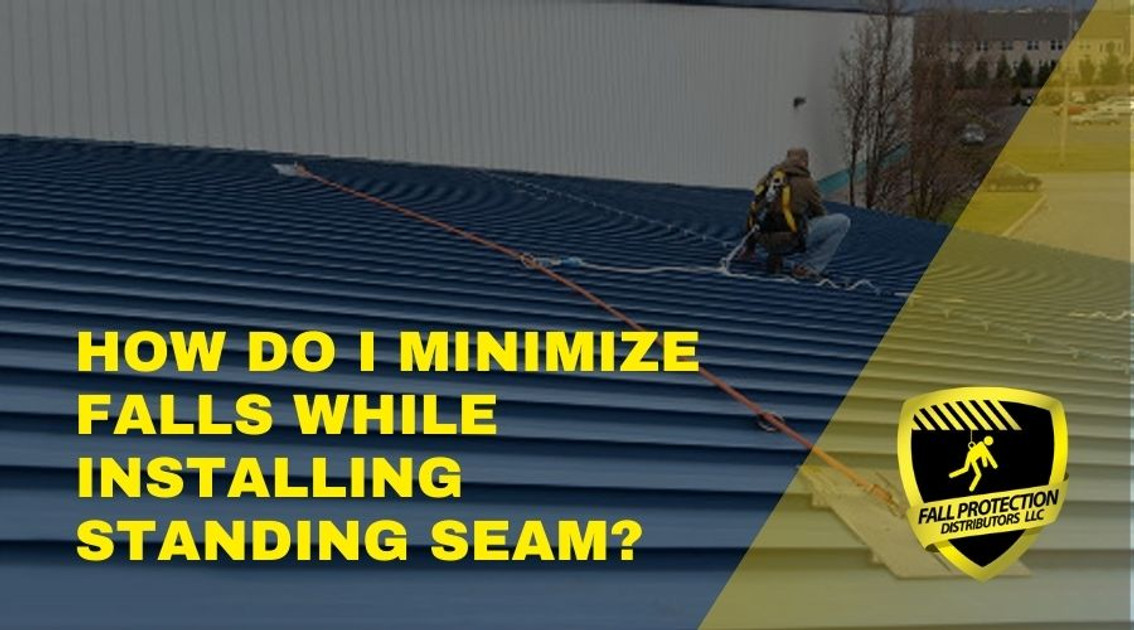How Do I Minimize Falls During Standing Seam Installations?
Posted by Howie Scarboro - CEO Fall Protection Distributors, LLC on Feb 9th 2024
Standing seam metal roofs offer timeless beauty and unparalleled durability, but their installation process presents unique challenges – particularly when it comes to safety. Navigating steep inclines and handling sharp metal sheets demands unwavering attention to detail and a commitment to fall prevention.
This blog serves as your comprehensive guide to mitigating fall risks and ensuring a safe, successful standing seam metal roof installation. We'll delve into the major fall hazards, explore various fall protection options, and equip you with crucial safety tips to prioritize your well-being and that of your crew. Let's embark on this journey towards a safer, more secure roofing experience!
Now, let's delve into each of your chosen questions and provide informative answers based on the OSHA's recommendations.
What are the biggest risks associated with installing standing seam metal roofs?
Unveiling the Top Fall Hazards in Standing Seam Metal Roof Installation
Standing seam metal roofs, with their sleek aesthetics and enduring performance, are a popular choice for residential and commercial buildings. However, their installation demands vigilance regarding fall hazards, as navigating steep inclines and handling sharp metal sheets presents inherent risks. Here's a breakdown of the major fall dangers you need to be aware of:
1. Precarious Perches:
The very nature of working on an inclined roof surface increases the risk of falls. Uneven surfaces, loose roofing materials, and sudden weather changes can further amplify the danger.
2. Slippery Slopes:
Metal surfaces, especially when wet, can become treacherous, increasing the possibility of slips and falls. Rain, dew, or condensation can transform your worksite into a perilous ice rink.
3. Edge Encounters:
Working near roof edges is inherently risky, requiring heightened awareness and proper fall protection measures. Leaning over unguarded edges to secure panels or retrieve tools can lead to disastrous consequences. Swing falls can cause rope abrasion issues on leading edges so a proper safety plan should address these serious challenges when working on any metal roof.
4. Material Mayhem:
Lifting and maneuvering heavy metal panels can result in muscle strain, back injuries, and potential falls if proper lifting techniques and equipment are not utilized.
5. Unstable Anchors:
Improperly chosen or installed fall protection anchors can negate their effectiveness, leading to a false sense of security and potentially disastrous outcomes in case of a fall.
6. Tool Troubles:
Dropped tools can be a hazard to workers below on the roof and on the ground. Be sure that all loose tools are tethered with properly designed lanyards designed specifically for that purpose. Damaged or malfunctioning tools can also increase the risk of accidents and falls.
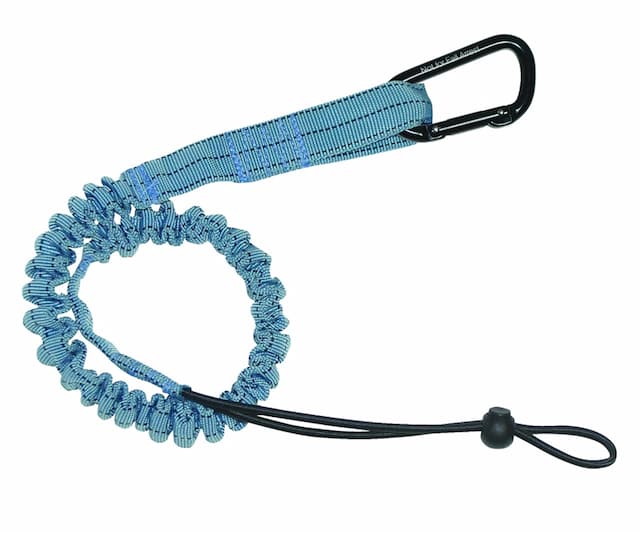
7. Weather Woes:
Unexpected wind gusts, sudden downpours, and extreme temperatures can create hazardous conditions and contribute to slips, falls, and even tool-related accidents.
By acknowledging these top fall hazards and prioritizing safety measures, you can transform your standing seam metal roof installation project into a success story, for both the aesthetics of your building and the well-being of your crew.
Remember: This list is not exhaustive and a comprehensive safety plan should consider all potential risks specific to your worksite and project. Always prioritize adherence to OSHA regulations and best practices for fall protection in roof construction.
2. What is the most common equipment used for standing seam fall protection?
Safeguarding Your Steps: Exploring Fall Protection Options for Standing Seam Metal Roofs
Standing atop a metal incline demands unwavering commitment to fall prevention. Thankfully, various fall protection options can equip you and your crew to navigate the project with confidence. Let's explore the pros and cons of each:
1. Personal Fall Arrest Systems (PFAS):
Pros: Offers maximum mobility and freedom of movement. Ideal for navigating complex roof structures and varied tasks.
Cons: Requires careful selection and installation of anchor points. Can be physically demanding due to constant connection to the system.
A good example of this would be a complete kit including the anchor, vertical lifeline, rope grab, and harness. The RidgePro Bundle has pretty much all a worker would need to maintain 100% tieoff from the ladder to the roof, until safely back to the ladder.
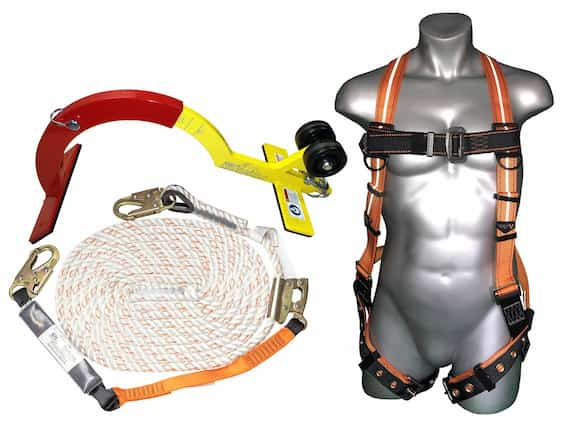
2. Guardrails:
Pros: Provides a physical barrier, eliminating the risk of falls over edges. Easy to install and readily available.
Cons: Limits mobility and access to certain areas of the roof. May not be feasible for complex roof shapes or frequent movement.
3. Horizontal Lifelines:
Pros: Offers temporary fall protection for specific tasks across the entire roof surface. More affordable and portable than permanent systems.
Cons: Should not be used for more than 2 workers at a time when mounted to standing seam roofs. It is suggested that workers should clip off the horizontal lifeline to a fixed anchor point once they reach their work zone.
Standing Seam Roof Anchor offers the SSRA HLL kit that allows the deployment of a 100' horizontal lifeline to standing seam roofs with zero penetrations.
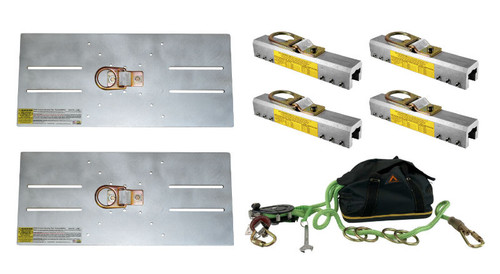
4. Standing Seam Roof Anchors:
Pros: Designed specifically for standing seam roofs, offering secure attachment without damaging the surface. Easy to install and remove.
Cons: May not be suitable for all roof pitches or seam configurations. Ensure compatibility with your specific roof type.
Choosing the Right Gear:
The ideal fall protection solution depends on several factors:
Roof pitch and complexity:
Steeper pitches and intricate structures might necessitate PFAS for optimal access.
The Standing Seam Roof Anchor SSRA1 is specifically engineered to solve these challenges for workers requiring reliable non-penetrating anchorage on standing seam roof systems.
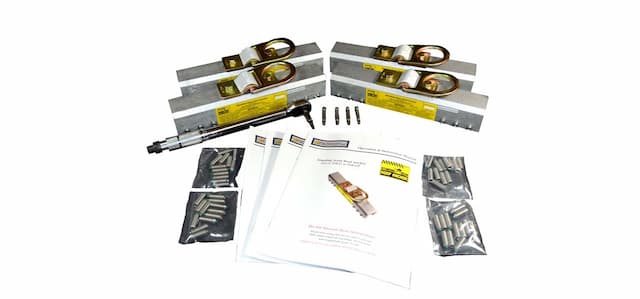
Tasks involved:
Frequent movement across the roof favors PFAS, while stationary tasks near edges might benefit from guardrails or brackets.
Budget and resources:
Consider the initial cost, installation complexity, and ongoing maintenance requirements of each option.
Remember:
Always adhere to OSHA 1926.501 regulations and consult qualified professionals for guidance on choosing and installing fall protection systems.
Regular inspection and maintenance of your chosen system are crucial for ensuring its effectiveness.
Combine different fall protection options for comprehensive coverage in complex scenarios.
By carefully evaluating your project needs and utilizing the appropriate fall protection gear, you can transform your standing seam metal roof installation into a safe and successful endeavor.
3. How to choose the right fall protection for your specific job site?
Finding Your Fit: Tailoring Fall Protection to Your Standing Seam Metal Roof Project
Standing seam metal roofs offer aesthetic appeal and lasting protection, but navigating their installation demands a customized approach to fall protection. Selecting the right gear isn't a one-size-fits-all situation, so here's how to tailor your choices for optimal safety:
1. Decipher Your Roof's Terrain:
Pitch and Complexity: Steeper inclines and intricate roof shapes often demand the flexibility of Personal Fall Arrest Systems (PFAS). Conversely, simpler roofs with accessible edges might benefit from guardrails or roof brackets.
Surface Conditions: Identify potential hazards like wetness, loose materials, or uneven surfaces that could increase slip risks. Consider slip-resistant boots and additional precautions depending on the conditions .
2. Analyze Your Work Scope:
Task Variety: If your project involves frequent movement across the roof, opt for a mobile solution like PFAS. Stationary tasks near edges can find suitable protection with guardrails or standing seam roof clamps.
Duration and Frequency: Short-term projects might favor temporary roof brackets, while long-term installations might necessitate a more permanent solution like guardrails or PFAS.
3. Factor in Resources and Regulations:
Budget: Evaluate the initial cost, installation complexity, and ongoing maintenance requirements of each option. Standing seam roof clamps and roof brackets might be more affordable, while PFAS systems often require professional installation.
OSHA Compliance: Always prioritize adherence to OSHA regulations for fall protection in residential and commercial construction. Familiarize yourself with the specific requirements for your project and roof type.
Additional Considerations:
Weather Factors: Choose weather-appropriate gear and be prepared to modify your approach based on wind, rain, or extreme temperatures.
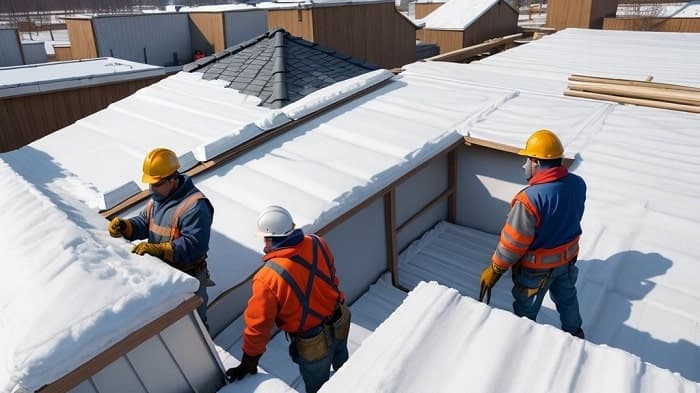
Crew Training: Ensure your team receives proper training on the chosen fall protection system and its safe use.
Inspections and Maintenance: Regularly inspect and maintain your fall protection equipment to ensure its effectiveness.
Remember: This information serves as a general guide, and it's crucial to consult qualified professionals for your specific project. They can help you assess your individual needs, evaluate different options, and choose the fall protection solution that best safeguards your crew and ensures a safe and successful standing seam metal roof installation.
4. What are some additional safety tips for installing standing seam metal roofs?
Beyond the Gear: Essential Safety Tips for Standing Seam Metal Roof Installation
While fall protection equipment forms the crucial first line of defense, a truly safe standing seam metal roof installation demands a holistic approach to safety. Here are some additional tips to prioritize well-being throughout your project:
1. Knowledge is Power:
Training: Ensure your crew undergoes comprehensive training on proper roof safety procedures, fall protection system usage, and hazard recognition.
Communication: Establish clear communication protocols to alert colleagues of potential hazards and coordinate movements on the roof.
Emergency Plan: Develop a documented plan outlining emergency response procedures, first-aid protocols, and contact information for medical services.
2. Preparedness is Key:
First-Aid Kit: Keep a well-stocked first-aid kit readily available to address minor injuries promptly.
Weather Monitoring: Stay updated on weather forecasts and adjust your work schedule or procedures to avoid working in dangerous conditions like high winds or heavy rain.
Sun Protection and Hydration: Implement measures to stay hydrated and protect yourself from sun exposure, especially during hot weather.
3. Material Management Matters:
Lifting Techniques: Utilize proper lifting techniques and equipment to prevent muscle strain and back injuries when handling heavy metal panels.
Debris Removal: Regularly remove scrap metal and debris to create clear walking paths and minimize trip hazards.
Secure Loose Panels: Tie down loose panels to prevent them from being blown off by wind or falling onto workers below.
4. Maintenance Matters:
Tool Safety: Inspect tools regularly for damage or malfunction. Use non-sparking tools specifically designed for metal roofs.
Anchor Inspections: Regularly inspect fall protection anchors for wear and tear or damage to ensure their reliability.
Housekeeping: Maintain a clean and organized worksite to minimize clutter and potential tripping hazards.
5. Remember:
Fatigue is Foe: Schedule breaks to avoid fatigue, which can impair judgment and increase the risk of accidents.
Never Work Alone: Always have at least one other person present on the roof in case of emergencies.
Seek Professional Help: When unsure about any safety aspect, consult qualified professionals for guidance and support.
By incorporating these additional safety tips alongside your chosen fall protection measures, you can create a work environment that prioritizes the well-being of your crew and guarantees a successful and safe standing seam metal roof installation. Remember, safety is not just a priority; it's an investment in the health and well-being of everyone involved in the project.
Take a few minutes to read OSHA's guide to the best practices for jobsite fall protection.
In Conclusion
So, you're ready to embark on the exciting journey of installing a stunning standing seam metal roof! But before you grab your hammer and head skyward, remember: safety isn't an afterthought, it's the foundation of a successful project.
We've tackled the top fall hazards lurking on those metal inclines, explored various fall protection options like trusty PFAS and handy roof brackets, and even shared crucial tips for choosing the right gear for your specific job site. Remember, factors like roof pitch, task variety, and even weather conditions play a key role in selecting the safest approach.
But safety doesn't stop at equipment. From proper training and clear communication to vigilant weather monitoring and meticulous tool maintenance, a holistic approach is essential. Think of it as building layers of protection, just like the beautiful seams on your soon-to-be roof!
And hey, if you're feeling a little overwhelmed by all the safety considerations, don't fret! Here at Fall Protection Distributors, LLC, we're passionate about helping you achieve a safe and successful standing seam metal roof installation.
Visit us at www.standingseamroofanchor.com and let's discuss your project. We'll guide you through the various fall protection options, answer your questions, and help you choose the solution that best fits your needs and budget. Remember, prioritizing safety isn't just about OSHA regulations, it's about safeguarding your crew and ensuring a smooth, stress-free project.
So, climb aboard with confidence, knowing you have the knowledge and support to conquer those peaks – safely!

